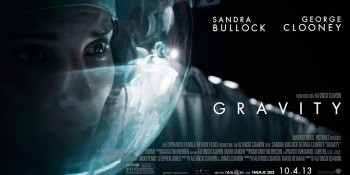Since the Academy of Motion Picture Arts and Sciences expanded the Best Picture category to allow between five and 10 nominees beginning with the awards that honored films released in 2009, a predictable pattern seems to have emerged. Slots are reserved for different classifications of films: the crowd-pleaser, the avant garde, the historical drama, the female-driven triumph, the performance piece, the Hollywood self-congratulation, and more. This year, Gravity was nominated in what I like to call the Avatar slot: a stunning showcase of technological marvel.
Like James Cameron’s CGI-fest of four years ago, Gravity demonstrates the state of the art of movie-making. The cinematographers, graphic artists, sound technicians, and other visual and audio masters of the movies flex their muscles to demonstrate the farthest reaches of what today’s technology can display on our screen and what, a decade from now, will be the standard in any well-produced film. This is necessary, this is welcomed, and this is marvelous.
However, to win Best Picture, a film must typically achieve success outside of the narrow set of characteristics that defines the “slot” through which it earned a nomination: artistic direction combined with powerful acting, for example, or a compelling historical narrative brought to life by performances that rattle the audience. Unfortunately for Alfonso Cuarón and company, Gravity does not break out of its pigeonhole.
Gravity is visually stunning; this has been covered extensively, and by more capable hands, elsewhere. It should and will take home the Oscar for Cinematography, as well as many of the technical awards. And the film does offer more than just breathtaking views of space and the planet rotating below.
The movie is expertly paced, keeping the viewer on the proverbial edge of his seat from start to finish. Telling the story in near-real-time is intriguing and does not feel gimmicky, as it might in less capable hands. The science is generally sound — at least sound enough that the viewer can reasonably suspend disbelief for the duration of the movie with few exceptions (navigation by fire extinguisher?).
And Sandra Bullock does a superb job with the script and range of character she is given. But that compliment leads directly into the discussion of what the film lacks.
Readers may have noticed that, more than halfway through this review, I have not even mentioned the plot of Gravity. That’s because there isn’t much to say: Bullock’s Ryan Stone is a scientist working in space. Debris hits the spacecraft she is stationed on and all other outposts in nearby orbit. People die; Stone is left alone to find her way back to Earth. Straightforward and sparse.
The paper-thin plot comes across as an afterthought to the visual presentation of the film, and that is not the only shortfall; the characterization is also woefully inadequate. The attempt to humanize Stone with a contrived back story falls flat. Only one other character, Commander Matt Kowalski (George Clooney), appears on-screen, and Clooney either succeeded immeasurably in creating an obnoxious, aloof, unlikable space cowboy or, what seems more likely, did not deliver a strong performance in what should have been a simple role (which is easy for a non-actor to say, I’m sure).
Contrary to what you may believe if you’ve read my previous review of The Wolf of Wall Street, I don’t hate movies that are designed to be fun or escapist; I quite enjoyed Gravity. I wish I had seen it in October, before the crush of Oscars season, to enjoy and evaluate it in the way it was designed to be consumed. In fact, I’ve given lip service to the visual effects of Gravity, but I must say I would likely have been more impressed had I seen the film in a theater. (As it was, I watched it at home, on demand.)
I also did not see the 3D version, which would have left yet another impression, I’m sure. (I appreciate that Cuarón has said he did not want the 3D aspects to be a gimmick, but I still got that impression, even in 2D, early in the movie.) I hope Gravity will see a wide re-release after the Academy Awards, so that those like me who skipped seeing it on the big screen the first time around will have a second chance. I would urge anyone in that boat to take advantage of the opportunity.
In the end, though, this delightful film cannot be a serious contender for Best Picture. No matter whether it is viewed in 2D or 3D, Gravity is successful in only one dimension, and that just won’t be enough.
